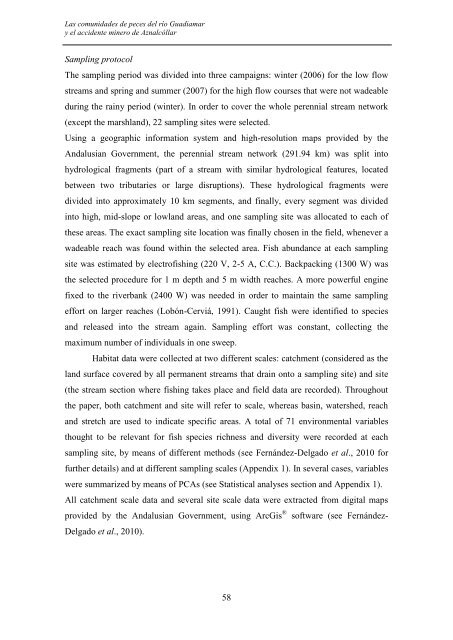las comunidades de peces del río guadiamar y el accidente minero ...
las comunidades de peces del río guadiamar y el accidente minero ...
las comunidades de peces del río guadiamar y el accidente minero ...
Create successful ePaper yourself
Turn your PDF publications into a flip-book with our unique Google optimized e-Paper software.
Las <strong>comunida<strong>de</strong>s</strong> <strong>de</strong> <strong>peces</strong> <strong>de</strong>l <strong>río</strong> Guadiamar<br />
y <strong>el</strong> acci<strong>de</strong>nte <strong>minero</strong> <strong>de</strong> Aznalcóllar<br />
Sampling protocol<br />
The sampling period was divi<strong>de</strong>d into three campaigns: winter (2006) for the low flow<br />
streams and spring and summer (2007) for the high flow courses that were not wa<strong>de</strong>able<br />
during the rainy period (winter). In or<strong>de</strong>r to cover the whole perennial stream network<br />
(except the marshland), 22 sampling sites were s<strong>el</strong>ected.<br />
Using a geographic information system and high-resolution maps provi<strong>de</strong>d by the<br />
Andalusian Government, the perennial stream network (291.94 km) was split into<br />
hydrological fragments (part of a stream with similar hydrological features, located<br />
between two tributaries or large disruptions). These hydrological fragments were<br />
divi<strong>de</strong>d into approximat<strong>el</strong>y 10 km segments, and finally, every segment was divi<strong>de</strong>d<br />
into high, mid-slope or lowland areas, and one sampling site was allocated to each of<br />
these areas. The exact sampling site location was finally chosen in the fi<strong>el</strong>d, whenever a<br />
wa<strong>de</strong>able reach was found within the s<strong>el</strong>ected area. Fish abundance at each sampling<br />
site was estimated by <strong>el</strong>ectrofishing (220 V, 2-5 A, C.C.). Backpacking (1300 W) was<br />
the s<strong>el</strong>ected procedure for 1 m <strong>de</strong>pth and 5 m width reaches. A more powerful engine<br />
fixed to the riverbank (2400 W) was nee<strong>de</strong>d in or<strong>de</strong>r to maintain the same sampling<br />
effort on larger reaches (Lobón-Cerviá, 1991). Caught fish were i<strong>de</strong>ntified to species<br />
and r<strong>el</strong>eased into the stream again. Sampling effort was constant, collecting the<br />
maximum number of individuals in one sweep.<br />
Habitat data were collected at two different scales: catchment (consi<strong>de</strong>red as the<br />
land surface covered by all permanent streams that drain onto a sampling site) and site<br />
(the stream section where fishing takes place and fi<strong>el</strong>d data are recor<strong>de</strong>d). Throughout<br />
the paper, both catchment and site will refer to scale, whereas basin, watershed, reach<br />
and stretch are used to indicate specific areas. A total of 71 environmental variables<br />
thought to be r<strong>el</strong>evant for fish species richness and diversity were recor<strong>de</strong>d at each<br />
sampling site, by means of different methods (see Fernán<strong>de</strong>z-D<strong>el</strong>gado et al., 2010 for<br />
further <strong>de</strong>tails) and at different sampling scales (Appendix 1). In several cases, variables<br />
were summarized by means of PCAs (see Statistical analyses section and Appendix 1).<br />
All catchment scale data and several site scale data were extracted from digital maps<br />
provi<strong>de</strong>d by the Andalusian Government, using ArcGis ® software (see Fernán<strong>de</strong>z-<br />
D<strong>el</strong>gado et al., 2010).<br />
58

















